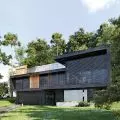The Main Post Office in Krakow is an iconic building for residents. What will happen to it? How will its function change and how should it affect the downtown landscape? These questions always arise, with every new information about the building.
Andrzej Lisowski and Wojciech Miecznikowski of the BE DDJM studio responsible for the hotel project talk about the design process for the iconic Krakow building, what it means to change its function to a hotel, and how the compromise is being built.
Wiktor Bochenek: How did you approach such an iconic building as the Main Post Office, not only from the architects' perspective, but also from the residents'. How do you perceive the expectations, with what is to happen there, and was it a difficult process?
Wojciech Miecznikowski: It was a difficult process. Many concepts and many options were considered, although looking now at the building as a property and the stagnant architectural substance, we now know that there weren't really many options. Nonetheless, there were all sorts of considerations about the size of the building, outbuildings and how to divide and use the main building.
As usual, we made models along with the urban planning part, showing how the building changed over time and how the outbuilding could be shaped. The main building, being listed as a historic building, is under the protection of not only what is the value of the listing itself, but also what is confirmed in the Local Development Plan. These are unshakable things that we preserve.
This is what it looked like during Habsburg rule (photo from 1926)
© Zeitgeist Asset Management press materials
Victor: During the preparation of the project, you worked with conservators, but also inventoried the building yourself. What kind of things did you discover at the post office. Did you find anything that Cracovians might not have realized?
Wojciech: You are asking about actually two things. Immediately after Zeitgeist purchased this building, 3D scans of the entire building were taken. On this basis, an inventory documentation was created. Such a scan makes it possible to document many elements that photography does not convey. The second issue is historical research, which was conducted by the team of Dr. Marek Lukach, and then the duties were taken over by the team of Bozena Boby-Dyga. A compilation of historic elements was made, as well as stratigraphic and architectural research in the object, amounting to more than seven hundred excavations. All this shows the thoroughly documented history of the building.
We need to be aware of what the Post Office building was. It was not a residential building, a palace or an average office - it was a model postal building and was designed as such by Ferdinand Setz of Vienna. From its inception, the building met the needs of the post office, which is why I call it a technology building. All later transformations are also the result of changes in technology.
post office after modernist reconstruction
© Zeitgeist Asset Management press materials
Wiktor: For example?
Wojciech: The decision by the Polish Post Office Telegraf Telefon company in the 1930s to expand the post office was due to the fact that the telephone exchange already handled more than five thousand numbers and needed more space. Postal services had grown, and it was more important to provide modern customer service than a formal entrance hall with a neo-Renaissance staircase and bust of Franz Joseph. Frederick Tadanier redesigned the Post Office, adding two stories and eliminating the Neo-Renaissance dome, built an "outbuilding - parcel house" and completely changed the architectural expression, in keeping with the modernist spirit of Greater Krakow.
This is a symptom of the building's adaptation to the technology that is its life. The last major renovation, which was in the 1990s, did not bring an expansion, but transformations inside the building itself. The dome, which Frederick Tadanier, in transforming the building from Neo-Renaissance to Modernist, eliminated, was restored. This dome, as well as some of the interiors, is, by the way, the result of the influence of Krier and Hollein's postmodernism trends of the time. It fits debatably, but the building was registered with this dome. And now the most significant recent change, also dictated by changes in communications technology and the specifics of today's postal services, is the sale of most "postal" real estate in Poland. The post office, as such, left for itself part of the first floor in the wing facing Wielopole Street, and the communication part - the server rooms, were placed in the basement, already without the participation of the always hitherto indispensable telephonists.
bird's eye view of the building today
© Zeitgeist Asset Management press materials
Wiktor: During the design process you had to refer to this patchwork of Austro-Hungarian, Tadanier, post-war and post-modern elements. What, taking a new functional form, will be preserved?
Wojciech: For me personally at the post office, the most important thing to preserve is the post office as a Place in Krakow. Cracovians have always made appointments either at Adas or at the Post Office. And just as no one asked which Adas it was, the Post Office also defined the place in the city unequivocally. This is the role that must remain, for which every effort must be made.
The second value comes from the statement, by Professor Jacek Purchla, that "... the previous question of how to protect monuments has taken the form of - how monuments should be transformed. The goal, which used to be the protection of historic values, is changing into another: the use of these values...". This is for us the main idea behind the transformation of this building. We want to do it in such a way that the most important elements from an architectural and historical point of view, its structure, remain unchanged. The layout of the corridor and the two room tracts remains as ideal for the inscribing new needs.
On the other hand, when we talk about the value of the building, all things related to the former use should be the attraction of the building.
bird's eye view of the post office project
© Zeitgeist Asset Management press materials
Wiktor: How should these elements be exposed.
Andrzej Lisowski: All the paint decorations will be uncovered and then it will be possible to assess what is to be preserved and how to best and most effectively carry out conservation work. The work will be carried out in conjunction with conservation committees. This is not a "whim" of the designers or investors. For now, we know what is there and in which lots we can expect to find valuable remains, but we don't know what condition they might be in. We can juxtapose the historic element restored with the elements restored on its model.
Wojciech: This is certainly a conservation decision and an interior concept decision. It doesn't make the slightest sense to recreate the entire painting decoration in a literal way. In the room on the second floor and in the "tube" of the corner tower, we have exposed fragments that show the degree of preservation and deterioration, which also has its charm.
Wiktor: Was it a difficult challenge to introduce hotel spaces into this space?
Andrzej: The three-tract layout itself, in fact, the hotel function may not dictate, but it does indicate. However, the hotel, in addition to the room area, has accompanying functions in the form of a restaurant or conference center, for example.
Wojciech: This corridor-room layout was built that way, because technological facilities such as the post office operated that way. This layout has been preserved one hundred percent.
Andrzej: That's also how offices worked back then. If today you tried to implement a modern office function into the building, it might not be entirely successful, because today we have different standards and ways of working. Something like that would be difficult to implement.
visualization of the lobby of the new hotel
© Zeitgeist Asset Management press materials
The rest of the interview is available on the next page


































